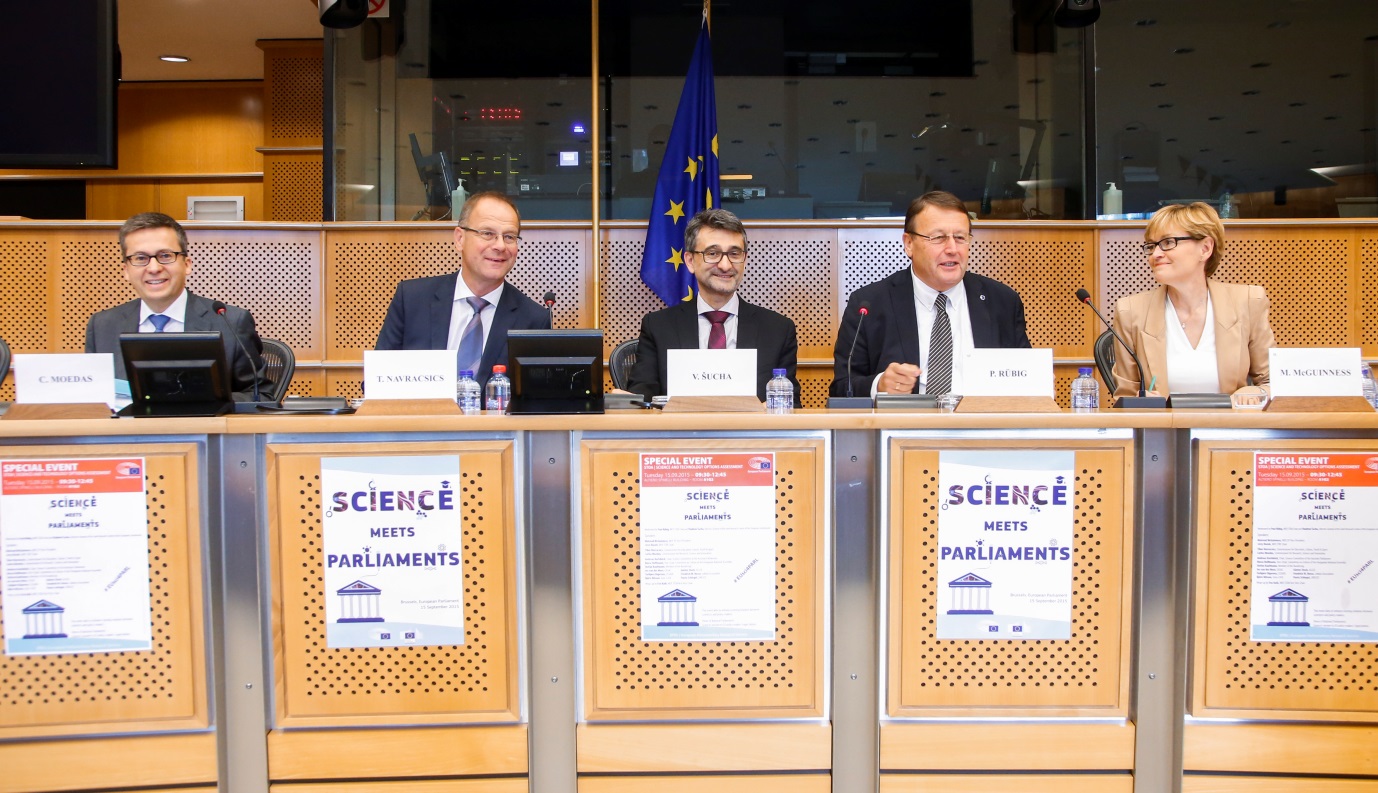Written by Nera Kuljanic and Zsolt G. Pataki
Scientists from all over Europe met with Members of the European and national parliaments on 15 September 2015 for ‘Science meets Parliaments’, an event co-hosted by the Science and Technology Options Assessment (STOA) Panel of the European Parliament (EP) and the Joint Research Centre (JRC) of the European Commission. The event launched the 4th round of STOA’s ‘MEP-Scientist Pairing Scheme’, which aims to promote a culture of science-based policy-making in the EP by helping create lasting links between scientists and MEPs. Matching the objectives of the new JRC initiative ‘Science meets parliaments’, which stresses the importance of science for evidence-informed policy-making, the project raises awareness of politically relevant, cutting-edge scientific issues, to create a structured dialogue between scientists and policy-makers.
[tweet https://twitter.com/Moedas/status/643715883492352000 align=’center’ width=’300′]
Speakers at the opening session included Tibor Navracsics, EU Commissioner for Education, Culture, Youth & Sport, whose responsibilities include the JRC; Carlos Moedas, EU Commissioner responsible for Research, Science and Innovation; Mairead McGuinness, MEP, EP Vice-President responsible for STOA; and Jerzy Buzek, MEP, Chairman of the EP Committee on Industry, Research and Energy (ITRE). The session was moderated by Paul Rübig, Chairman of the STOA Panel and Vladimír Šucha, JRC Director-General.
Speakers underlined the need for more effective use of existing EU institutional scientific expertise (e.g. JRC, agencies, EP research services) and the importance of better communication between policy-makers and scientists. Mairead McGuinness stressed the time constraints politicians often face, but also that technological developments facilitate ever faster access to information. She also reiterated Commissioner Moedas’ comments on the importance of trust among scientists, politicians and citizens. Jerzy Buzek added that the role of science is to provide evidence-based options to decision-makers, not final answers.
[tweet https://twitter.com/Europarl_EN/status/643691002037932032 align=’center’ width=’300′]
Eva Kaili, MEP and STOA Vice-Chair, presented the MEP-Scientist Pairing Scheme, for which she is responsible within the STOA Panel, noting that the recently launched fourth round of the scheme sparked a lot of interest in the scientific community; with over 300 scientists and researchers from all over Europe applying to be ‘paired’ with an MEP. Members are now in the process of choosing their ‘scientific counterparts’, after which the pairs will meet in Brussels, probably during November 2015, when the scientists will accompany and possibly assist Members in their daily political activities. As a follow-up, the scientist-Member pairs will have the opportunity to organise an event with a European dimension on a topic of their choice.
[tweet https://twitter.com/BrianVad/status/643731486244478976 align=’center’ width=’300′]
The MEP-Scientist Pairing Scheme launch was very well attended, the meeting room remaining packed from the beginning to the end of the event. A record number of 25 MEPs registered their interest, and most of them attended the sessions. If you were unable to attend in person, watch our video instead.

































[…] Kaili MEP, STOA Vice-Chair, officially inaugurated the project on 15 September during the ‘Science Meets Parliaments‘ event in the […]
[…] Eva Kaili MEP, STOA Vice-Chair, officially inaugurated the project on 15 September during the ‘Science Meets Parliaments‘ event in the […]
[…] Eva Kaili MEP, STOA Vice-Chair, officially inaugurated the project on 15 September during the ‘Science Meets Parliaments‘ event in the […]
[…] the 4th time. The project was officially introduced by the First STOA Vice-Chair Eva KAILI at the ‘Science meets Parliaments’ event, which STOA organised, together with the European Commission’s in-house science service, […]
[…] the 4th time. The project was officially introduced by the First STOA Vice-Chair Eva KAILI at the ‘Science meets Parliaments’ event, which STOA organised, together with the European Commission’s in-house science service, […]
[…] and technological developments is crucial to MEPs’ policy-making role. Ensuring MEPs have regular access to reliable information is an essential part of the European Parliament’s Science and Technology Options Assessment […]
[…] and technological developments is crucial to MEPs’ policy-making role. Ensuring MEPs have regular access to reliable information is an essential part of the European Parliament’s Science and Technology Options Assessment […]
[…] ensuring that MEPs have regular access to reliable information is essential. For this reason the very successful fourth round of the scheme is followed by this fifth […]